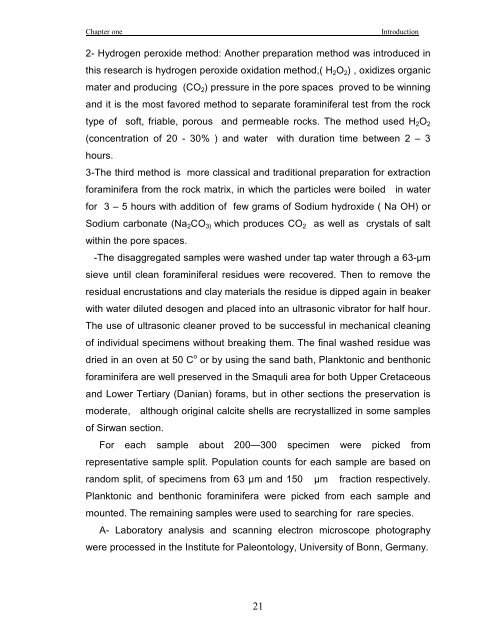biostratigraphy and paleoecology of cretaceous/tertiary boundary in ...
biostratigraphy and paleoecology of cretaceous/tertiary boundary in ...
biostratigraphy and paleoecology of cretaceous/tertiary boundary in ...
Create successful ePaper yourself
Turn your PDF publications into a flip-book with our unique Google optimized e-Paper software.
Chapter one<br />
Introduction<br />
2- Hydrogen peroxide method: Another preparation method was <strong>in</strong>troduced <strong>in</strong><br />
this research is hydrogen peroxide oxidation method,( H 2 O 2 ) , oxidizes organic<br />
mater <strong>and</strong> produc<strong>in</strong>g (CO 2 ) pressure <strong>in</strong> the pore spaces proved to be w<strong>in</strong>n<strong>in</strong>g<br />
<strong>and</strong> it is the most favored method to separate foram<strong>in</strong>iferal test from the rock<br />
type <strong>of</strong> s<strong>of</strong>t, friable, porous <strong>and</strong> permeable rocks. The method used H 2 O 2<br />
(concentration <strong>of</strong> 20 - 30% ) <strong>and</strong> water with duration time between 2 – 3<br />
hours.<br />
3-The third method is more classical <strong>and</strong> traditional preparation for extraction<br />
foram<strong>in</strong>ifera from the rock matrix, <strong>in</strong> which the particles were boiled <strong>in</strong> water<br />
for 3 – 5 hours with addition <strong>of</strong> few grams <strong>of</strong> Sodium hydroxide ( Na OH) or<br />
Sodium carbonate (Na 2 CO 3) which produces CO 2 as well as crystals <strong>of</strong> salt<br />
with<strong>in</strong> the pore spaces.<br />
-The disaggregated samples were washed under tap water through a 63-µm<br />
sieve until clean foram<strong>in</strong>iferal residues were recovered. Then to remove the<br />
residual encrustations <strong>and</strong> clay materials the residue is dipped aga<strong>in</strong> <strong>in</strong> beaker<br />
with water diluted desogen <strong>and</strong> placed <strong>in</strong>to an ultrasonic vibrator for half hour.<br />
The use <strong>of</strong> ultrasonic cleaner proved to be successful <strong>in</strong> mechanical clean<strong>in</strong>g<br />
<strong>of</strong> <strong>in</strong>dividual specimens without break<strong>in</strong>g them. The f<strong>in</strong>al washed residue was<br />
dried <strong>in</strong> an oven at 50 C o or by us<strong>in</strong>g the s<strong>and</strong> bath, Planktonic <strong>and</strong> benthonic<br />
foram<strong>in</strong>ifera are well preserved <strong>in</strong> the Smaquli area for both Upper Cretaceous<br />
<strong>and</strong> Lower Tertiary (Danian) forams, but <strong>in</strong> other sections the preservation is<br />
moderate, although orig<strong>in</strong>al calcite shells are recrystallized <strong>in</strong> some samples<br />
<strong>of</strong> Sirwan section.<br />
For each sample about 200—300 specimen were picked from<br />
representative sample split. Population counts for each sample are based on<br />
r<strong>and</strong>om split, <strong>of</strong> specimens from 63 µm <strong>and</strong> 150 µm fraction respectively.<br />
Planktonic <strong>and</strong> benthonic foram<strong>in</strong>ifera were picked from each sample <strong>and</strong><br />
mounted. The rema<strong>in</strong><strong>in</strong>g samples were used to search<strong>in</strong>g for rare species.<br />
A- Laboratory analysis <strong>and</strong> scann<strong>in</strong>g electron microscope photography<br />
were processed <strong>in</strong> the Institute for Paleontology, University <strong>of</strong> Bonn, Germany.<br />
21

















